 |
|
| In late April, U.S. Army Captain Andrew Summers
Rowan, in disguise, entered the enemy lines
in Oriente, crossed the island of Cuba, and
made contact with Cuban General Garcia. Rowan
also gathered maps and important intelligence
information about existing military conditions
on the island. The U.S. North Atlantic Squadron
left Key West for Cuba on April 22 following
the frightening news that the Spanish fleet
under Admiral Pascual Cervera had left Cadiz,
slipped past U.S. ships commanded by William
T. Sampson and Winfield Scott Schley, and entered
Havana Harbor. The U.S. fleet arrived in Cuba
in late May. |
|
|
Cuban
Ground Operations
US commanders planned to capture the city of Santiago
de Cuba in order to destroy General Arsenio Linares'
army and Admiral Pascual Cervera's fleet. At that
time Spanish troops stationed on the island included
150,000 regulars and 40,000 irregulars and volunteers
while rebels inside Cuba numbered as many as 50,000.
Total U.S. army strength at the time totalled
26,000, requiring the passage of the Mobilization
Act of April 22 that allowed for an army of at
first 125,000 volunteers (later increased to 200,000)
and a regular army of 65,000. After a lengthy
and messy embarkation process from Tampa, Marines
captured Guantánamo Bay, and 17,000 troops
landed at Siboney and Daiquirí on June
22, east of Santiago, where they established a
base of operations. After a brief skirmish near
Siboney on June 23, a contingent of Spaniards
assumed lighty entrenched positions at Las Guasimas.
Ignoring |
|
|
| reports of Cuban scouting partiesand orders from above to use caution, an advance
guard under former Confederate General Joseph Wheeler
caught up with and engaged the Spanish rear guard
on June 24. The fight, known as the Battle of Las
Guasimas, was essentially a Spanish ambush. The
skirmish was significant in that it revealed to commanders
that the tatics of employing Civil War-era skirmishers
at the head of advancing columns did not work effectively
against Spanish troops who had learned the art of
cover and concealment while dealing with Cuban insurgents,
and never made the error of revealing their positions
while on the defense. The Spaniards were also aided
by the innovation of smokeless powder. American soldiers
were only able to advance against the Spaniards in
what are now called "fireteam" rushes; four-to-five
man groups advancing while others laid down supporting
fire. The battle ended indecisively in favor of Spain
and the Spanish left Las Guasimas on their planned
retreat to Santiago. |
|
American forces continued on toward Santiago. To
reach the city, they had to pass through concentrated
Spanish defenses in the San Juan Heights and a small
town in El Caney. General William Rufus Shafter commanded
about 15,000 troops in three divisions. Jacob F. Kent
commanded the 1st Division, Henry W. Lawton commanded
the 2nd Division, and Joseph Wheeler commanded the
Cavalry Division but was suffering from fever and
had to turn over command to General Samuel S. Sumner.
Shafter's plans to attack Santiago de Cuba called
for Lawton's division to move north and attack the
Spanish stronghold at El Caney on July 1. It was expected
that Lawton could accomplish this in about two hours,
at which time he was to join with the rest of the
troops for the attack on the San Juan Heights later
in the day.
Battles of El Caney:
At El Caney, 500 Spanish soldiers under General Joaquín
Vara del Rey were instructed to hold the northwest
flank of Santiago against the American attack. Despite
having no machine guns or artillery and being denied
promised reinforcements, Vara del Rey and his soldiers
held Lawton and over 8,000 Americans from their position
for nearly twelve hours, preventing them from sweeping
through and overwhelming the defenders of San Juan
Hill. The Americans took staggering losses: over 80
dead and 350 wounded. Precise Cuban losses at El Caney
are not known, but the Cuban irregulars also suffered
heavily, losing around 150 killed and wounded that
day. Many have called this engagement proof that,
properly led, the Spanish Army might well have defeated
the United States during the Cuban Campaign. |
|
San Juan Heights: July 1, 1898
At the sound of Lawton's guns at El Caney
in the early morning hours of July 1, Sumner's
dismounted cavalry followed by Kent's infantry
began marching down the El Pozo Road toward
the San Juan River. The road soon became crowded
as infantry, cavalry and news correspondents
bunched up waiting for Lawton's division to
arrive from El Caney.
Lieutenant Colonel Edward J. McClernand of
Shafter's staff, rode to the front and set up
a post on El Pozo Hill. At about 7 a.m. "Fighting
Joe" Wheeler heard the sound of gunfire,
arose from his sickbed and rode to the front.
Upon arriving at El Pozo Hill, Wheeler became
the senior front line officer and began discussing
the course of action with McClernand. The advance
then resumed with Colonel |
|
|
| Henry K. Carrol's
cavalry brigade in the lead followed by Brig.
Gen. Leonard Wood's brigade. The cavalry crossed the San Juan River and veered off to the right,
while Hamilton S. Hawkins led his infantry brigade
off to the left. A company from the signal corps ascended in a hot air
balloon to reconnoiter the hills. Though it made for
a good target for the Spaniards and was shot down, it
was aloft long enough for its officers to discover another
path leading up the slope. Hawkins' brigade had already
passed by the new found route and Kent ordered forward
the brigade under Colonel Charles A. Wikoff. It was
12 p.m. by the time Wikoff began heading down the trail,
and a half an hour later he emerged from the woods and
was struck by a bullet. He died as his staff officers
carried him to the rear. Next in command was Lt. Col.
William S. Worth who assumed command but within five
minutes fell wounded. Lt. Col. Emerson Liscom assumed
command and within another five minutes received a disabling
wound. Lt. Col. Ezra P. Ewers, fourth in command of
the brigade, assumed command. Kent and Sumner lined up for the attack and waited
for Lawton's division to arrive from El Caney. Lawton,
of course, did not arrive as scheduled, and no orders
came from either Shafter or Wheeler. The troops simply
waited at the base of the hill. Under constant Spanish
gunfire, the men soon dubbed the areas "Hell's
Pocket" and "Bloody Ford". |
|
Many of the officers grew, including Lt. Colonel
Theodore Roosevel, grew impatient waiting for
orders while suffering casualties. It was Roosevelt,
as Assistant Secretary of the Navy, who had actively
encouraged intervention in Cuba and placed the
Navy on a war-time footing. It was Roosevelt who
had ordered Commodore George Dewey and the Pacific
fleet to the Philippines, and along with Leonard
Wood, had convinced the Army to raise an all-volunteer
regiment, the 1st U.S. Volunteer Cavalry. Wood
was given command of the regiment that quickly
became known as the "Rough Riders".In
the absence of orders, Roosevelt took it upon
himself to lead an advance up the hill. Facing
the Rough Riders was a smaller hill which received
the name Kettle Hill because the Americans found
a large kettle near the base. Roosevelt formed
his regiment and began to advance. The advance
began to |
|
slow as troops droppedfrom heat exhaustion.
Roosevelt feared that he could not keep up on
foot in the tropical heat and instead stayed mounted.
Soon officers from the rest of
Wood's brigade along with Carrol's brigade began to
advance, and the units became intermingled. Two of the
units involved were the 9th and 10th Cavalry of "Buffalo
Soldiers." These regular army African American
units were well seasoned following years of deployment
in the hostile Western regions of the country against
resistant American Indians. One of the 10th Calvary's
lieutenants in attendance was John J. "Black Jack"
Pershing, who would later attain fame during America's
involvement in World War I.
The regulars reached a depression
in the hill and stopped to fire. Roosevelt ordered the
troops to charge. When the regulars refused because
no orders to do so came from the brigade commanders,
Roosevelt led his volunteers past and charged up the
hill. The attackers, employing an extremely dangerous
Civil War style frontal assault, cut their way through
barbed wire fences and drove the Spaniards out of their
trenches on Kettle Hill. |
|
In the meantime Hamilton Hawkins' brigade was faring
no better than Roosevelt had in his original position.
A brigade staff officer named Lt. Jules G. Ord tried
to convince his superior to allow him to lead a volunteer
charge. Hawkins responded "I will not ask for
volunteers, I will not give permission and I will
not refuse it," he said. "God bless you
and good luck!" Ord then moved his brigade out
of the trenches and advanced up the slope. General
Hawkins apparently was not opposed to the attack since
once the men began he joined in directing the two
lead regiments. 150 yards from the hill the troops
charged, cutting their way through the barbed wire.
Seeing the spontaneous advances of Roosevelt and
Ord, Wheeler gave the order for Kent to advance with
his whole division while he returned to the Cavalry
Division. Kent sent forward Ewers' brigade to join
Hawkins' men already approaching the hill. At San
Juan Hill, 750 Spanish soldiers had been ordered to
hold the heights against a combined force of about
15,000 US and Cuban troops. For reasons still not
quite clear, Spanish General Arsenio Linares failed
to reinforce this position, choosing to hold nearly
10,000 Spanish reserves in the city of Santiago. Spanish
hilltop entrenchments, while typically well-constructed,
had been poorly positioned, making even point-blank
rifle volleying at the advancing Americans difficult.
Kent's men soon discovered that they were covered
from Spanish fire while they climbed the hill. Ord,
still in the lead, was among the first to reach the
crest. The Spanish fled, but as Ord jumped into the
trench he was killed instantly and Hawkins was wounded
shortly after.
After losing Kettle Hill, Linares's men still on
San Juan Hill began to fire on the cavaliers' newly
won position. While Kent's secured a blockhouse to
the south after hand-to-hand fighting, Sumner also
charged San Juan Hill. Roosevelt personally led the
attack but paused after charging a few feet with only
a handful of men following. He turned around and inquired
why no one had followed. His men replied they had
not heard the order and quickly joined the attack.
Kent's remaining brigade under Colonel E. P. Pearson
arrived after Hawkins and Ewers had already charged
and moved further to the south and drove the Spanish
off of a knoll on the Spanish right flank.
General Wood sent requests for Kent to send up infantry
to strengthen his vulnerable position. General Wheeler
reached the trenches and ordered breastworks constructed.
Roosevelt's men did in fact repulse a minor counterattack
on the northern flank. The Americans' position on
San Juan Hill was exposed to artillery fire from within
Santiago, and Shafter feared the vulnerability of
the line and ordered the troops to withdraw. Wheeler
assured Shafter that the position could be held; still
Shafter ordered the withdrawal. |
Before the men could
withdraw Wheeler called aside Kent and Sumner and reassured them that the line could be held,
and during the night they worked at strengthening
the lines while reinforcements arrived.
In the assaults on the San Juan Heights, more
than 200 U.S. soldiers were killed and close
to 1,200 wounded in the fighting. Supporting
fire by Gatling guns was critical to the success
of the assault. Nevertheless, the battle had
been a hard one for the Americans, who suffered
almost three times as many losses as the Spanish
had. The Spaniards, meanwhile, had literally
fought to the knife, losing a third of their
force in casualties but yielding very few prisoners. |
|
|
| |
|
| |
After the battles of San Juan Hill and El Caney, the
American advance ground to a halt. Lawton's division,
which was supposed to join the fight early on July 1,
did not arrive until noon on July 2, having encountering
unexpectedly heavy resistance in the battle of |
| El Caney.
Spanish troops successfully defended
Fort Canosa, allowing them to stabilize their
line and bar the entry to Santiago. The Americans
and Cubans forcibly began a bloody, strangling
siege of the city. During the nights, Cuban troops
constructed a successive series of raised parapets
toward the Spanish positions. Once completed,
they were occupied by U.S. soldiers, and then
a new set of excavations went forward. American
troops, while suffering daily losses from Spanish
fire, suffered far more casualties from heat exhaustion
and mosquito-borne disease. At the western approaches
to the city Cuban general Calixto Garcia began
to encroach on the city, causing much panic and
fear of reprisals among the Spanish forces. The
Spanish finally surrendered Santiago on July 17. |

Yellow
Fever was transmitted by mosquitos |
|
|
The major port of Santiago was the main target
of naval operations during the war. In May 1898,
Spanish Admiral Pascual Cervera was first spotted
in Santiago Harbor where his fleet had taken
shelter for protection from sea attack. For
two months there was a stand-off between the
Spanish naval forces and American fleet, which
attacked out of Guantanamo Bay after its takeover
on June 6–June 10.
On July 3, two days after the ground operations
at El Caney and San Juan Heights, Admiral Cervera
decided to move his fleet out of Santiago. When
the Spanish squadron attempted to leave the
harbor, the American forces destroyed or grounded
five of the six ships. Only one Spanish vessel,
the speedy new armored cruiser Cristobal Colón,
survived, but her captain hauled down his flag
and scuttled her when the Americans finally
caught up with her. The 1,612 Spanish sailors
captured, including Admiral Cervera, were |
|
|
|
sent
to Seavey's Island at the Portsmouth Naval Shipyard
in Kittery, Maine, where they were confined at Camp Long as prisoners of war from July
11 until mid-September. The Battle of Santiago
on July 3, 1898, was the largest naval engagement
of the Spanish-American War and resulted in
the destruction of the Spanish Caribbean Squadron.
During the stand-off, United States Assistant
Naval Constructor Richmond Pearson Hobson had
been ordered by Rear Admiral William T. Sampson
to sink the collier Merrimac in the harbor to
bottle up the |
|
| Spanish fleet. The mission was
a failure, and Hobson and his crew were captured.
They were exchanged on July 6, and Hobson became
a national hero; he received the Medal of Honor
in 1933 and became a Congressman. |
|
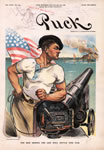
"The Man Behind The Gun Will Settle This War," Puck, July 13, 1898, by Joseph Keppler
|
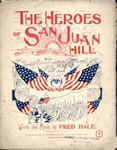
Sheet
Music: "The Heroes of San Juan Hill" |
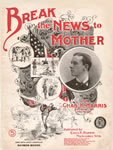
Sheet Music: "Break the News to Mother" (1897)
|

 "Break The News to Mother" by J.W. Myers (1904) "Break The News to Mother" by J.W. Myers (1904) |
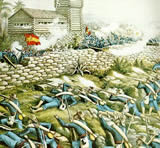
Print: Black infantry at San Juan Hill |

Stereoview of General Shafter (2 views)
|

Stereoview: Grimer Battery A, Santiago, Cuba (2 views)
|

Stereoview: 12-inch Coast Defense Gun (2 views)
|

Stereoview: Morro Castle Fortifications (3 views)
|

Souvenir Spoon: Morro Castle (3 views)
|

Stereoview: Spanish Cemetery in Cuba (2 views)
|
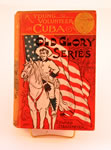
Children's Fiction: A Young Volunteer In Cuba (1898), by Edward Stratemeyer. From the Old Glory series |
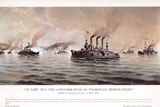
Alfonso Sanz Print, "Battle of Santiago de Cuba" (1898) |
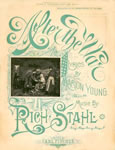
Sheet Music: "Afer The War" (1898) |
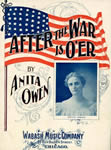
Sheet Music: "After The War is O'er" (1898) |
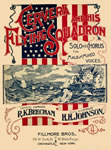
Sheet Music: "Cervera and His Flying Squadron" (1898) |
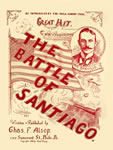
Sheet Music: "The Battle of Santiago" (1898) |
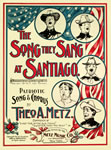
Sheet Music: "The Song They Sang at Santiago" (1898) |
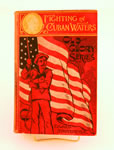
Children's literature: Fighting In Cuban Waters (1899) by Edward Stratemeyer, From the "Old Glory" series |
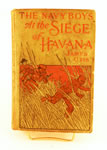
Children's literature: The Navy Boys at the Siege of Havana (1899), by James Otis |

 "On Board The Oregon", by Invincible Quartette (1902) "On Board The Oregon", by Invincible Quartette (1902) |
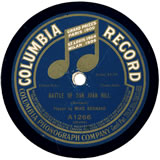
 "Battle of San Juan Hill", by Mike Bernard (1912) "Battle of San Juan Hill", by Mike Bernard (1912) |
|
|
|
|
| |
During May 1898, Lt. Henry H. Whitney of the United
States Fourth Artillery was sent to Puerto Rico on
a reconnaissance mission, sponsored by the Army's
Bureau of Military Intelligence. He provided maps
and information on the Spanish military forces to
the U.S. government prior to the invasion. On May
10, U.S. Navy warships were sighted off the coast
of Puerto Rico. On May 12, a squadron of 12 U.S. ships
commanded by Rear Adm. William T. Sampson bombarded
San Juan. During the bombardment, many government
buildings were shelled. On June 25, the Yosemite blockaded
San Juan harbor. On July 25, General Nelson A. Miles,
with 3,300 soldiers, landed at Guánica and
invaded the island with little resistance in the brief
Puerto Rican Campaign. |
| |
With both of its fleets destroyed, Spain sued for
peace. Hostilities were halted on August 12, 1898 with
the signing in Washington of a Protocol of Peace. Representatives
of Spain and the United States signed the formal peace
treaty in Paris on December 10, 1898. It was ratified
by the United States Senate on February 6, 1899, and
came into force on April 11, 1899.
|
|
|

|
|
|
|
|
|
|
|
|
|

